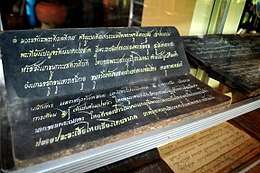Samut khoi
Samut khoi (Thai: สมุดข่อย, pronounced [sā.mùt kʰɔ̀j]; Lao: ສະໝຸດຂ່ອຍ; "khoi books") or samut thai (Thai: สมุดไทย, [sā.mùt tʰāj]) are a type of folding-book manuscript which were historically widely used in many Buddhist cultures, including Cambodia, Laos, Sri Lanka and Thailand, as well as in Myanmar, where they are known as parabaik. The techniques used in their production came probably from the ancient kingdom of Ceylon (today's Sri Lanka). They are usually made with the paper of the Siamese rough bush or khoi tree, and are not bound like Western books but are folded in an accordion style. Samut khoi are made either with black paper (in Thailand known as samut thai dam), or with white paper (samut thai khao). The use of samut khoi in Thailand dates to the Sukhothai period.[1] They were usually used for secular texts including royal chronicles, legal documents and works of literature, while palm-leaf manuscripts were more commonly used for religious texts.[2][3]

Khmer paper books
The paper used for the Khmer books, known as kraing, was made from the bark of the mulberry tree. In what we now know as Cambodia, the kraing literature was stored in pagodas across the country. During the Cambodian civil war and the subsequent Khmer Rouge regime of the 1960s and 1970s, as much as 80% of the pagodas in Cambodia were destroyed, including their libraries.[4] In Cambodia, only a tiny fraction of the original kraing of the Khmer Empire has survived.[5]
References
| Wikimedia Commons has media related to Samut khoi. |
- "The History of Paper". Nakorn Phanom National Library (Thailand).
- "สมุดข่อย และคัมภีร์ใบลาน กรุสมบัติจากบรรพชน" [Samut khoi and palm-leaf manuscipts: treasure troves from our ancestors]. Ayutthaya Studies Institute, Ayutthaya Rajabhat University. Retrieved 17 October 2015.
- Igunma, Jana (2013). "Southeast Asia (2): The Mainland". In Suarez, Michael F.; Woudhuysen, H. R. (eds.). The Book: A Global History. Oxford: Oxford University Press. ISBN 9780191668753.
- Sen David and Thik Kaliyann (19 September 2015). "Palm leaves preserving history". The Phnom Penh Post. 6.
- Prof. K. R. Chhem and M. R. Antelme (2004). "A Khmer Medical Text "The Treatment of the Four Diseases" Manuscript". Siksācakr, Journal of Cambodia Research. 6: 33–42.